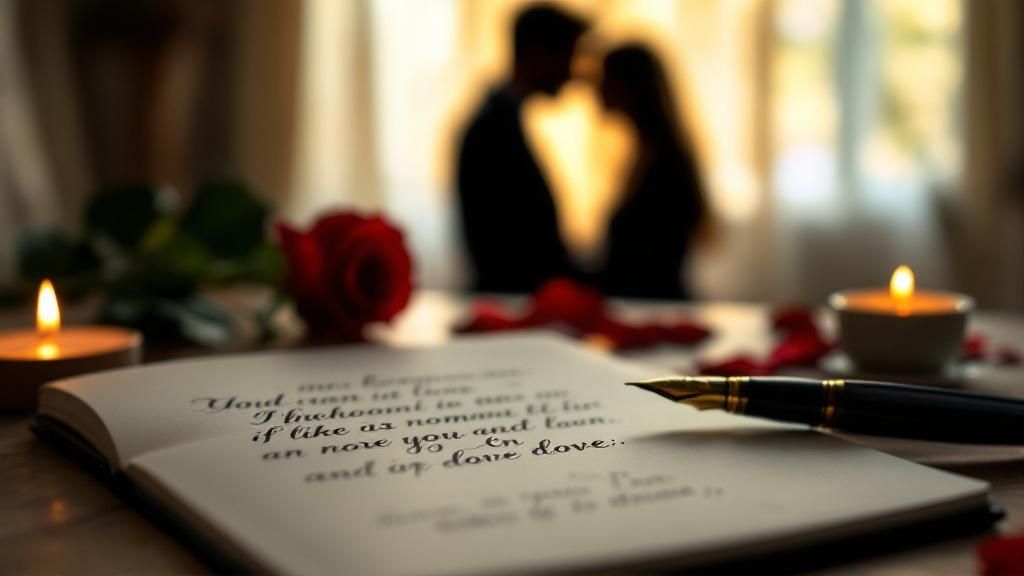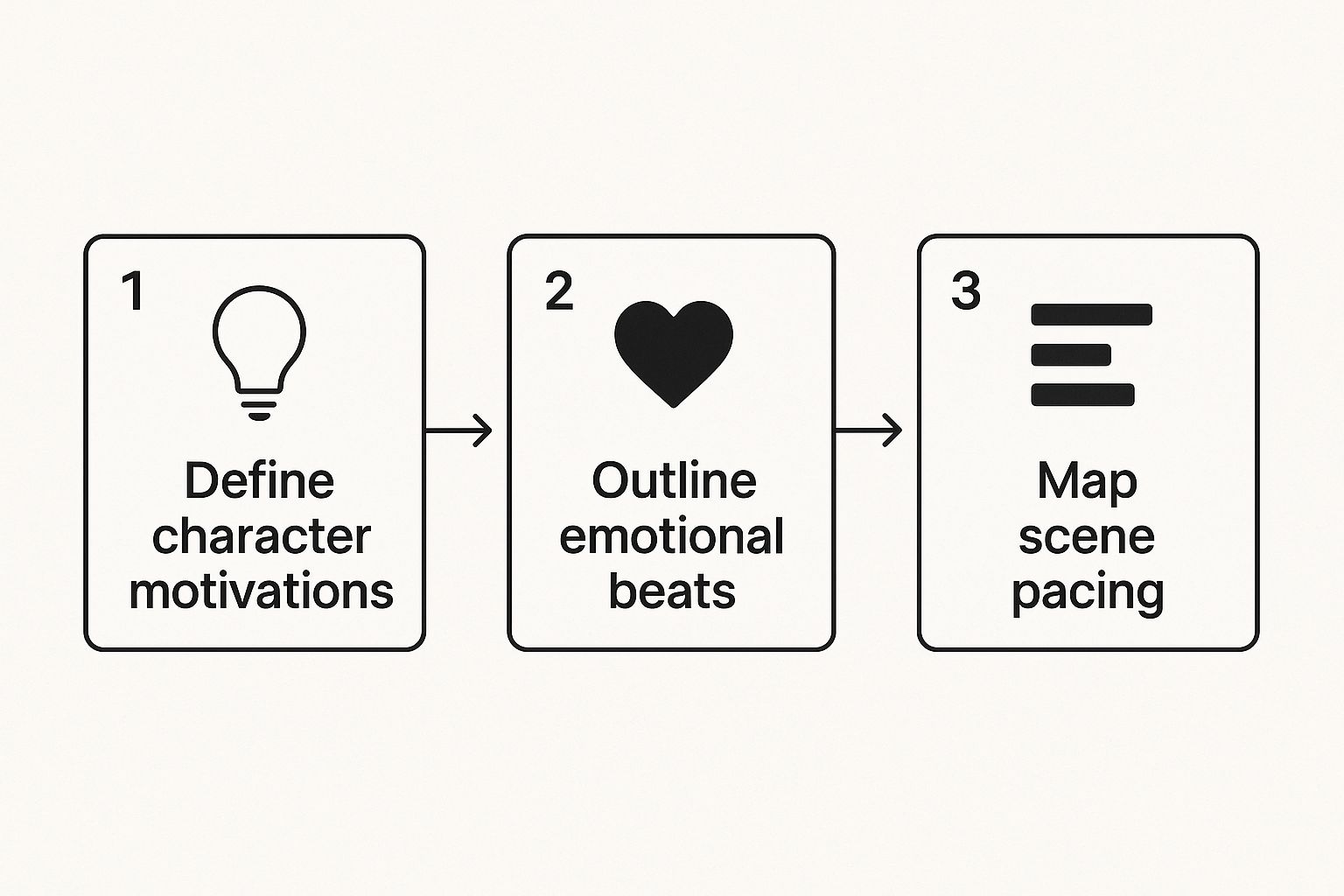Create Your Own AI Girlfriend 😈
Chat with AI Luvr's today or make your own! Receive images, audio messages, and much more! 🔥
4.5 stars

Before the first touch, the first whispered confession, or even the first shared, longing glance, a truly unforgettable romance scene has already been built. The magic isn't just in the action; it's in the why. It all comes down to laying a solid foundation of character motivation and emotional stakes.
What’s Really at Stake?
The secret to a scene that readers feel in their bones is understanding what each character wants and, just as importantly, what they fear in that specific moment.
Think about it. What does your character desperately hope to gain from this interaction? Is it a moment of connection they’ve been craving for chapters? Validation that their feelings are returned? Or maybe it’s something simpler, like a moment of peace in a chaotic world.
Now, flip that coin. What are they terrified of? The sting of rejection is an obvious one, but dig deeper. Are they afraid of being truly seen? Scared of losing control? Frightened that this moment of connection will be snatched away?
When you know the answers, the emotional stakes skyrocket. Suddenly, it’s not just a conversation; it’s a tightrope walk, and your reader is holding their breath with every step.
Align Every Scene with Your Plot
A romance scene just for the sake of it is like a beautifully decorated room with no doors—it looks nice, but it doesn't go anywhere. Every single romantic interaction needs to pull its weight in your broader narrative.
Ask yourself:
- Does this scene deepen the bond between the characters?
- Does it expose a critical vulnerability that will come back to haunt them later?
- Does it introduce a new conflict or complicate an existing one?
Every choice, every line of dialogue, every action should feel earned and have a consequence. A scene without a clear purpose can drag the whole story down, but one that moves the plot and the relationship forward feels satisfying and essential.

As you can see, the real work begins long before you start writing the dialogue. It’s all about intentional, character-focused planning.
To help you map this out, I've put together a quick reference table. Think of this as your pre-flight checklist before you dive into writing any romantic moment.
Core Components of a Romance Scene
| Component | Purpose | Key Question to Ask |
|---|---|---|
| Character Goal | Establishes the scene's driving force. | What does my character want to achieve in this moment? |
| Inner Conflict/Fear | Creates internal tension and stakes. | What is my character afraid will happen? |
| Plot Function | Ensures the scene serves the overall story. | How does this scene move the relationship or plot forward? |
| Emotional Arc | Maps the character's feelings from start to finish. | What emotional journey will my character go on? |
With these components defined, you're not just writing a scene; you're crafting an experience that feels both inevitable and surprising to the reader.
Why This Matters More Than Ever
The need for well-structured, emotionally resonant scenes isn't just good writing advice—it's a market necessity. The romance world has changed dramatically. While U.S. print romance sales impressively doubled from 18 million copies in 2020 to 39 million in 2023, that number reflects a complex market.
To stand out today, writers have to be sharper. The explosion of digital reading means authors need to craft concise, emotionally powerful scenes that hook readers fast. Today's audiences are also hungry for nuanced, psychologically complex relationships that go beyond old-school tropes. For a deeper dive, you can explore more data on the changing romance landscape and see what it means for your writing career.
A great romance scene never happens by accident. It's the deliberate result of weaving together character desire, plot necessity, and a clear emotional journey. Your job is to make the reader feel every ounce of hope, fear, and attraction your characters are experiencing.
Master the Art of Romantic Tension

Tension is the heart and soul of a great romance. It's that invisible string pulling your characters together while a thousand tiny forces try to keep them apart. It's the engine that fuels the reader's desperate question: "Will they or won't they?" If you want to learn how to write romance scenes that truly grip your audience, mastering tension isn't just a suggestion—it's everything.
This magnetic pull isn’t just about putting obstacles in their way, like a jealous ex or a family that disapproves. That’s the easy part. The most potent, unforgettable tension comes from the perfect blend of internal and external conflict. Frankly, a character's inner turmoil can be a far more powerful barrier than any physical one you can dream up.
Think about a character who desperately wants to love and be loved but is petrified of getting hurt again because of a past betrayal. The external conflict might be that their love interest lives in another city. But the real tension? That’s born from their internal fight every time they get close. Suddenly, every shared look isn't just a glance; it's a high-stakes moment freighted with meaning.
Slow Down to Speed Up the Heartbeat
Here’s a trick I learned that feels counterintuitive but works every time: when you feel a huge romantic moment brewing, resist the urge to get to the good part. Instead, slow everything down.
Zoom in. Focus on the microscopic details that make a moment feel real. Describe the way a character’s breath catches in their throat, the almost imperceptible shift in their weight, or the smell of summer rain clinging to their clothes. When you stretch out these fleeting seconds with sharp, sensory details, you pull the reader right into the scene, forcing them to feel the weight of every unspoken emotion.
Here's what I mean:
- Rushed Version: He leaned in and kissed her.
- Tension-Filled Version: He leaned in, his gaze dropping from her eyes to her lips. The air between them grew thick, charged and humming. She could feel the heat radiating from his skin, smell the faint scent of coffee and mint on his breath. Her own pulse hammered in her ears as the last few inches separating them vanished, agonizingly, deliciously slow.
That deliberate slowdown makes the emotional payoff infinitely more satisfying when it finally happens.
The secret to unbearable romantic tension is making the reader want something for the characters so badly that they feel the ache of its absence on every single page.
The Power of What Isn’t Said
Dialogue is important, of course. But what your characters don't say often speaks volumes. Subtext, body language, and loaded silences are your secret weapons for crafting nail-biting tension. An entire chapter's worth of emotion can be conveyed in a lingering touch, a hastily averted gaze, or a quiet moment that screams louder than any passionate declaration.
These non-verbal signals create a private, intimate language between your characters—one the reader gets a front-row seat for. Here are a few ways to build tension without a single word of revealing dialogue:
- Accidental Touches: Their hands brush when they both reach for the same book, sending a jolt through them that’s impossible to ignore.
- Meaningful Glances: One character catches the other watching them from across a crowded party, and they hold the gaze just a second too long before looking away.
- Proxemics (The Use of Space): Have them stand just a little too close to each other while talking, breaching normal social boundaries to create their own invisible bubble of intimacy.
By zeroing in on these subtle interactions, you build a rich, layered scene where every small movement is packed with unspoken meaning. It creates a palpable sense of anticipation that will have readers frantically turning the page, desperate to find out when—and how—that beautiful tension will finally break.
Craft Dialogue That Reveals and Resonates

In any romance, dialogue is the engine that drives connection. It's so much more than just clever back-and-forth; it’s your best tool for showing readers who your characters really are, advancing the story, and forging a bond that feels completely real.
Truly great romantic dialogue leaves surface-level chatter behind. Instead, it crackles with genuine emotion and weight, creating a dynamic dance between those lighthearted, playful exchanges and moments of pure, unvarnished vulnerability. Both are absolutely critical for building a believable intimacy.
The Give-and-Take of Intimacy
Think of every conversation as a window into your character's soul. How they speak tells us volumes about their upbringing, their current state of mind, and even their deepest insecurities. A character who defaults to formal language might be hiding behind a carefully constructed wall, while another might use sarcasm as a shield.
If you want to write romance scenes that truly land, you have to get comfortable with both the light and the heavy moments in conversation.
- Playful Banter: This is where you build rapport and let their chemistry shine. It's that quick, clever sparring that signals attraction and comfort. Think of two characters gently teasing each other about their terrible taste in movies—it’s a fun, low-stakes way to connect.
- Vulnerable Confessions: These are the moments that truly deepen the bond. When a character shares a secret, a fear, or a painful memory, they are handing over a piece of their heart, trusting the other person to hold it carefully.
A scene that expertly balances both of these feels so much more authentic. A rapid-fire, witty exchange can suddenly pivot into a quiet, serious confession, and in that turn, the reader sees the relationship gaining real depth.
The most memorable dialogue in romance isn’t just about what’s said, but what’s revealed. Every single word should either pull the characters closer together or expose a crack that threatens to push them apart.
Crafting a Unique Character Voice
Your characters shouldn't sound like you, and they certainly shouldn't sound like each other. Every person in your story needs a distinct voice that's been molded by their unique life experiences. A stoic, world-weary detective isn't going to talk like a bubbly, optimistic barista.
To nail down a character's voice, ask yourself:
- Word Choice: Do they use simple, direct words, or do they lean toward more complex and descriptive language?
- Rhythm and Pacing: Is their speech pattern short and punchy, or do they speak in long, flowing sentences?
- Speech Habits: Do they have a regional accent? Do they rely on certain slang words or catchphrases?
When you take the time to develop these distinct voices, your characters jump off the page. Their conversations become more than just words—they become a living, breathing part of their love story.
Make Them Feel It: Using the Senses for Total Immersion
If you want your reader to truly live inside a romance scene, you can't just tell them what the characters are seeing. A scene only becomes unforgettable when you weave in sensations that make the reader feel it in their own body. This isn't just about adding pretty descriptions; it's about grounding the emotion in something real and tangible.
Think of it like this: you're building a memory for the reader. Real memories are never just visual, are they? They’re tied to the specific smell of an old bookstore, the rough texture of a beloved sweater, or the faint taste of coffee on someone's breath.
The romance scenes that stick with us are the ones we don't just read—we feel them. Sensory details are how you make that happen, turning a simple moment into a fully immersive experience.
By anchoring your scene with these physical sensations, you give the abstract emotion of love a place to land. The reader feels the chilly autumn air on their skin right alongside the character, which makes the sudden warmth of an embrace that much more powerful.
More Than Just a Pretty Picture
We writers often lean on sight and sound as our go-to senses. They’re important, of course, but the other three—smell, touch, and taste—are where the real magic for intimacy often lies. They can sneak past the reader's analytical brain and trigger a gut reaction, making your scenes feel richer and more genuine.
Let’s dig into how you can layer these details for maximum impact:
- Smell: This is the sense most powerfully tied to memory. It's an incredible shortcut to emotion. Maybe the faint scent of chlorine from a public pool instantly yanks a character back to a clumsy teenage crush. Or the specific smell of old leather and pipe tobacco becomes the scent they'll forever associate with their love interest.
- Touch: For romance, this is the most intimate sense. Don't just say he gave her a soft kiss. What about the surprising heat of his skin against hers in the cold? The scratch of day-old stubble against her cheek? The cool, smooth slide of a silk dress under his fingertips?
- Taste: Taste can be intensely personal and revealing. It's not just about sharing a meal. It can be the salty tang of tears on a lover’s cheek, the lingering sweetness of wine on their lips, or even the metallic hint of fear in a character’s own mouth before they confess their feelings.
- Sound: Think beyond the dialogue. What about the almost-silent hitch in someone's breath that gives away their vulnerability? The distant rumble of a passing train that underscores the tension in the room? Or the frantic, muffled thumping of a character’s own heart, so loud it's all they can hear?
When you weave in these sensory anchors, the scene transforms from a description into a shared experience. Instead of just telling the reader your characters are falling in love, you're inviting them to feel every single sensation that forges that connection.
Write Intimacy With Emotional Impact

Physical intimacy in a romance story, whether it’s a long-awaited first kiss or something more, represents a major turning point. These moments are never just about physical actions. They're powerful narrative milestones that need to be absolutely packed with emotional weight.
The most memorable intimate scenes I've ever read (or written) always put the emotional core ahead of the physical choreography. Before you even think about describing a single touch, you have to nail down the why. What does this moment truly mean for your characters and the relationship you've so carefully built? A scene that lands perfectly feels like the natural, earned result of all the tension, banter, and shared moments of vulnerability that came before it.
Choreographing the Emotional Buildup
The real secret to a powerful intimate scene is the emotional buildup. It’s all about showing the character’s inner world—their hopes, their hesitations, their fears, and their desperate longing—as they finally stand on the edge of a new threshold. This isn't just about two people kissing. It’s about one character finally letting their walls down, or another taking a terrifying leap of faith.
To make that physical connection truly resonate, I always focus on these elements:
- Vulnerability: Have a character expose a weakness or a deep-seated fear right before the physical act. This raises the stakes in a huge way.
- Internal Monologue: Let us inside their head for a moment. Is their mind racing with a million what-ifs, or has the whole world gone quiet except for their awareness of the other person?
- Narrative Purpose: Constantly ask yourself what this scene is meant to accomplish. Is its job to solidify their bond? To massively complicate things? Or to fundamentally change who they are as individuals?
The most powerful intimacy isn't about what the characters' bodies are doing, but what their hearts are doing. Every touch should be an extension of their emotional journey.
Choosing Your Heat Level Wisely
One of the biggest calls you have to make when writing romance is just how explicit to get. The choice between a detailed, on-page scene and a more suggestive "fade-to-black" should always be deliberate. It needs to be driven by your specific story, your genre's conventions, and what your readers expect.
A fade-to-black can be incredibly powerful. It trusts the reader’s imagination to fill in the details, keeping the story's focus locked on the emotional fallout. On the other hand, an explicit scene can be a raw, potent way to explore your characters' connection, trust, and passion on a deeper level. There’s no single right answer, but the choice must serve the story you're telling.
If you're trying to brainstorm complex character interactions and test out different scenarios, a tool like the Luvr AI character builder can be a great way to explore different dynamics before you commit them to the page.
Ultimately, whether you show everything or just a little, the goal is always the same: prioritize the emotional impact. The physical intimacy must feel earned and meaningful, leaving your reader with a profound sense of who these characters are and what they mean to each other.
Keep Your Finger on the Pulse of Modern Romance
The romance genre isn't static. It's constantly evolving, shaped by what readers are craving right now. To write scenes that truly land with a modern audience, you need to understand the current market—what’s hitting the bestseller lists and why. It goes deeper than just picking a popular trope; it's about connecting with the cultural zeitgeist.
One of the biggest trends right now is the fusion of high-stakes plotting with the central love story. This is why subgenres like 'Romantasy' and 'Dark Romance' are absolutely exploding. These stories don't just focus on courtship. They embed the relationship's growth within life-or-death struggles, epic world-building, and thorny moral questions, creating scenes with incredible energy.
Embrace Flawed Characters and Moral Ambiguity
Modern readers are hungry for psychological depth. The age of the perfectly polished, squeaky-clean hero is fading. In his place, we see the rise of the anti-hero and the morally gray love interest. These characters are so compelling because their imperfections and inner conflicts make their rare moments of genuine connection feel earned and powerful.
When you're writing a scene with these types of characters, the tension isn't just about whether they'll get together. It’s deeply internal. A character might be falling for someone they’ve been taught to hate, or they might be torn between their heart's desire and a lifelong duty. This internal battle creates a much richer, more complex romantic arc that keeps readers completely hooked.
The most powerful romance scenes today often live in the gray areas of morality and love. They show us that profound connections can form in the darkest, most unexpected places, which makes the emotional reward for the reader that much sweeter.
Market data backs this up in a big way. Romance is a titan in adult fiction, with U.S. print sales reaching around 51 million units in a recent 12-month period. A huge driver of this growth is the audience's appetite for darker, more psychologically complex themes found in paranormal romance and dark fantasy, which are often outperforming traditional rom-coms. You can read the full research about shifting reader preferences to see the data for yourself.
You don't have to write a dark romance to tap into this trend. The key takeaway is that readers want emotional intensity. Weaving suspense, moral ambiguity, and high stakes into your scenes—no matter your subgenre—will give your writing a fresh, contemporary feel.
To get a better sense of how different subgenres handle these elements, here’s a quick breakdown of what readers expect from their scenes.
Popular Romance Subgenres and Scene Expectations
| Subgenre | Key Scene Element | Reader Expectation |
|---|---|---|
| Contemporary | Relatable Conflict | Scenes grounded in modern-day problems like career stress, family drama, or social challenges. The romance feels real and achievable. |
| Romantasy | World-Building & Magic | Scenes where romantic tension is heightened by magical abilities, political intrigue, or epic quests. The fate of the world often hangs in the balance. |
| Dark Romance | Power Dynamics & Taboo | Scenes that explore intense psychological themes, morally ambiguous characters, and taboo relationships. High emotional stakes are a must. |
| Historical | Social Constraints | Scenes where love must overcome rigid societal rules, class divides, and historical events. The tension comes from forbidden love. |
| Romantic Comedy | Witty Banter & Situational Humor | Lighthearted scenes driven by clever dialogue, funny misunderstandings, and "meet-cute" scenarios. The focus is on charm and laughter. |
Understanding these expectations helps you deliver the specific kind of emotional payoff your readers are looking for.
For more inspiration, it can be incredibly helpful to see what's currently resonating with readers. Exploring a collection of popular romance tags and stories is a great way to see how authors are successfully using these modern trends in their own work.
Answering Your Toughest Romance Scene Questions
Even with all the right ingredients, sometimes a romance scene just doesn't click. That’s perfectly normal. Over the years, I’ve seen writers wrestle with the same few challenges. Let's tackle them head-on with some practical, no-nonsense answers.
What's the Real Difference Between Tension and Conflict?
This one trips up a lot of writers, but the distinction is actually pretty simple.
Think of it like this: conflict is the big, obvious wall standing between your characters, while tension is the crackling energy in the air because of that wall.
Conflict is the tangible obstacle. It could be a bitter family rivalry, a professional ethics code that forbids their relationship, or a deep-seated personal fear of intimacy. It's the "why they can't be together."
Tension, on the other hand, is the emotional and psychological result of that conflict. It’s the charged silence across a crowded room, the way their fingers almost brush when passing a salt shaker, the heavy, unspoken "what if?" that hangs between them. You absolutely need both; conflict gives the story stakes, but tension is what makes readers hold their breath.
How Do I Make a First Kiss Truly Unforgettable?
Here's a secret: a memorable first kiss is almost never about the mechanics of the kiss itself. It's all about the emotional weight behind it—what it resolves and what it complicates. To nail it, you need to zoom in on the moments just before and just after.
- The Lead-Up is Everything: Don't rush this. Slow the scene way down. Let us live inside your point-of-view character's head. What do they see? The flicker of uncertainty in the other person's eyes? The way they bite their lip? Describe the shaky inhale, that last split-second of hesitation, or the tiny, non-verbal cue that says, "Yes, you can."
- The Aftermath Changes the Game: The world should feel different after the kiss. This is the point of no return. Does it bring a rush of stunning clarity or a wave of terrifying confusion? The emotional fallout is what sears the moment into a reader’s memory.
A truly great first kiss should feel both completely inevitable and utterly surprising. It’s the explosive release of all the tension you’ve so carefully built, proving this connection was the only possible destination.
My Romance Scene Feels Lifeless. What's Wrong?
If a scene falls flat, it’s almost always for one of two reasons: the stakes are too low, or the inner emotional journey is missing. The fix starts with going back to your character's core motivations for that specific scene.
What does each person in that room desperately want? And what are they terrified of losing if they act on it?
Once you know the answer, dial up their internal conflict. If your scene is just two people having a polite conversation, you need to inject subtext. Let their body language betray them. A character might say, "I'm fine," but the white-knuckled grip on their coffee mug tells a much more interesting story. That contrast between words and actions is where the real emotional depth lives.
If you're looking for more ways to diagnose and fix your scenes, you can find a whole library of writing advice over on the Luvr AI blog.
At Luvr AI, we're obsessed with what makes connections feel real. You can explore our AI characters to see how unique personalities and deep emotional layers can spark inspiration for your own unforgettable stories. Find your next muse at https://www.luvr.ai.



